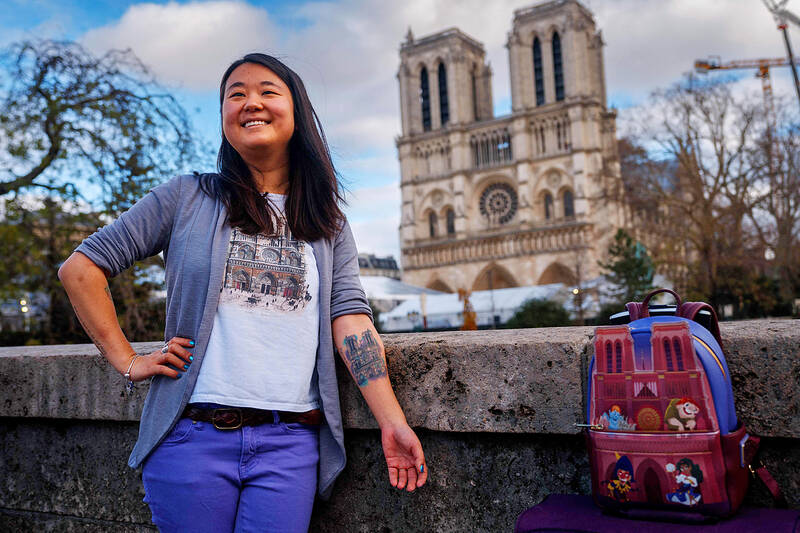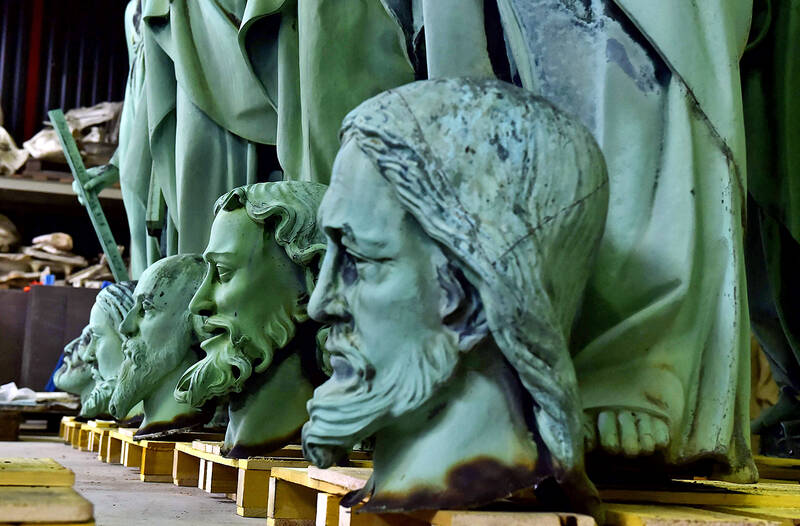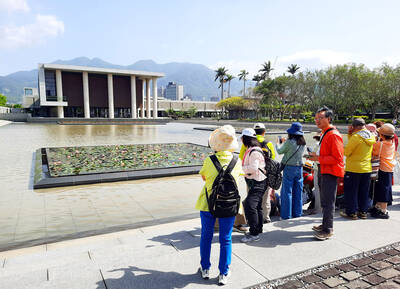The more than five-year reconstruction of Notre Dame cathedral has featured some near-miraculous recoveries, as well as several controversies. Ahead of the official reopening of the cathedral on Saturday, we look at some of the key moments:
THE SAVIORS

Photo: AFP
Paris firefighters won universal praise for their swift and decisive action on the evening of April 15, 2019, with officers later saying they thought they were only 30 minutes away from seeing the structure collapse.
Battling smoke and the risk of falling debris, they formed a human chain with church officials to evacuate the most precious artifacts and religious treasures, helping preserve most of the cathedral’s irreplaceable contents.
Others saw divine intervention in how a copper statue of a rooster that had sat atop the building’s incinerated 19th-century spire was found afterwards intact amid the scorched rubble.

Photo: AFP
Its contents — three relics, including a small piece of the Crown of Thorns supposedly worn by Jesus before his crucifixion — also survived, with the battered rooster now on display in a Paris museum. Inside the cathedral, images the day after the blaze revealed that a giant gold cross on the altar was still standing amid the still smoldering wreckage, a symbol of hope and defiance for many on a dark day for Christians and the country at large.
CONTESTED DESIGN CONTEST
French President Emmanuel Macron called the fire “an opportunity to come together” but any sense of national unity after the disaster quickly broke down.
His suggestion that an “element of modern architecture” be included in the rebuild drew immediate criticism from conservatives who demanded that the reconstruction be faithful to the last major update by architect Eugene Viollet-le-Duc in 1844.
The army general put in charge of the rebuild publicly fell out with the lead architect over the redesign, while entries for an architectural competition to select a new spire resulted in lurid headlines.
One suggestion shown by First Lady Brigitte Macron to then-culture minister Roselyne Bachelot resembled a “phallus with its base surrounded with golden balls,” Bachelot wrote in a book.
In the end, a replica of the old spire was built. Six new stained glass windows are set to be installed featuring work by contemporary artists — a modest nod to modernity and Macron’s original vision.
LEAD ROLE
Notre Dame’s roof and spire were covered by around 400 tonnes of lead, a toxic heavy metal that melted and vaporized with the heat of the fire, with some of it thought to have polluted the surrounding area.
Authorities cleaned nearby schools and advised local residents to wipe surfaces in their homes because of the risk of poisoning.
A health charity joined forces with a union and parents of local schoolchildren to lodge a criminal complaint in 2022 that accused authorities of failing to take every precaution to prevent pollution.
Charges are possible if authorities or contractors are found to have been negligent in protecting the health of residents or workers sent in to decontaminate the site, with an investigating magistrate overseeing a probe.
CAUSE UNKNOWN
The chief Paris prosecutor at the time of the fire, Remy Heitz, said shortly after the inferno that he believed that an accident such as an electrical fault or a cigarette butt was the most likely cause.
Some of the workers renovating the roof at the time of the fire were known to have smoked on site, but investigators have never been able to pinpoint the exact starting point.Speculation about an arson attack has been investigated during five years of forensic analysis, but no evidence was found.
The current chief Paris prosecutor Laure Beccuau said in April that “the closer we have got to the spot the fire started, and the more results of analyses come back, the more weight is lent to the theory of an accident.”
FEE ROW
Culture Minister Rachida Dati has proposed that visitors to the restored cathedral pay a five-euro (US$5.25) entry ticket, with the funds set to be routed to some 4,000 churches in need of repairs around France.
Charging for entry — entering Notre Dame was previously free — would bring the tourist attraction into line with St Paul’s cathedral in London or Milan’s Duomo.
But senior French church leaders have criticized the idea, with a senior bishop saying churches and cathedrals had “always been places open to all” and making money from visitors would be a “betrayal of their original vocation.”
The French state owns Notre Dame and has the final say.

When the South Vietnamese capital of Saigon fell to the North Vietnamese forces 50 years ago this week, it prompted a mass exodus of some 2 million people — hundreds of thousands fleeing perilously on small boats across open water to escape the communist regime. Many ultimately settled in Southern California’s Orange County in an area now known as “Little Saigon,” not far from Marine Corps Base Camp Pendleton, where the first refugees were airlifted upon reaching the US. The diaspora now also has significant populations in Virginia, Texas and Washington state, as well as in countries including France and Australia.

On April 17, Chinese Nationalist Party (KMT) Chairman Eric Chu (朱立倫) launched a bold campaign to revive and revitalize the KMT base by calling for an impromptu rally at the Taipei prosecutor’s offices to protest recent arrests of KMT recall campaigners over allegations of forgery and fraud involving signatures of dead voters. The protest had no time to apply for permits and was illegal, but that played into the sense of opposition grievance at alleged weaponization of the judiciary by the Democratic Progressive Party (DPP) to “annihilate” the opposition parties. Blamed for faltering recall campaigns and faced with a KMT chair

Article 2 of the Additional Articles of the Constitution of the Republic of China (中華民國憲法增修條文) stipulates that upon a vote of no confidence in the premier, the president can dissolve the legislature within 10 days. If the legislature is dissolved, a new legislative election must be held within 60 days, and the legislators’ terms will then be reckoned from that election. Two weeks ago Taipei Mayor Chiang Wan-an (蔣萬安) of the Chinese Nationalist Party (KMT) proposed that the legislature hold a vote of no confidence in the premier and dare the president to dissolve the legislature. The legislature is currently controlled

Dull functional structures dominate Taiwan’s cityscapes. But that’s slowly changing, thanks to talented architects and patrons with deep pockets. Since the start of the 21st century, the country has gained several alluring landmark buildings, including the two described below. NUNG CHAN MONASTERY Dharma Drum Mountain (法鼓山, DDM) is one of Taiwan’s most prominent religious organizations. Under the leadership of Buddhist Master Sheng Yen (聖嚴), who died in 2009, it developed into an international Buddhist foundation active in the spiritual, cultural and educational spheres. Since 2005, DDM’s principal base has been its sprawling hillside complex in New Taipei City’s Jinshan District (金山). But